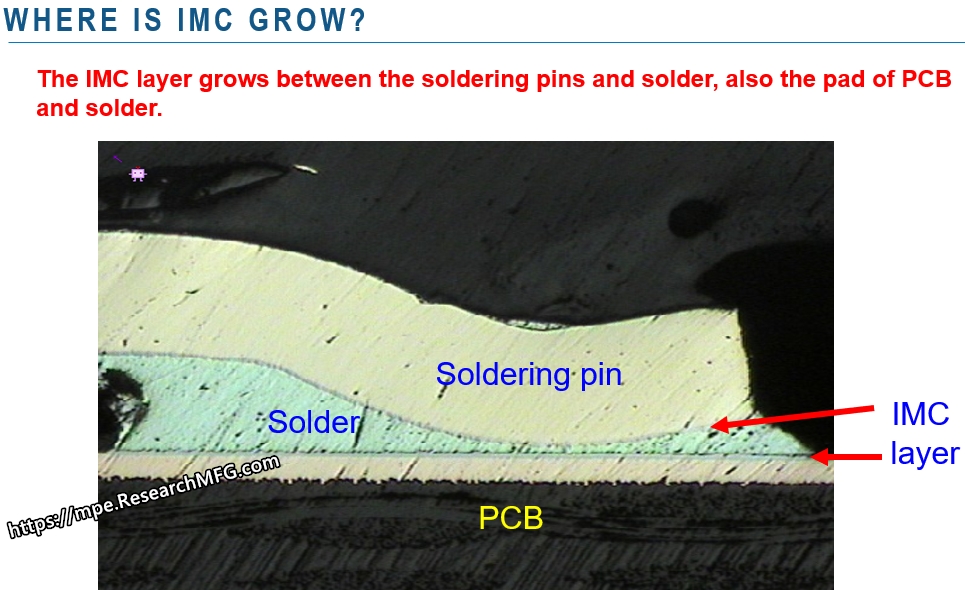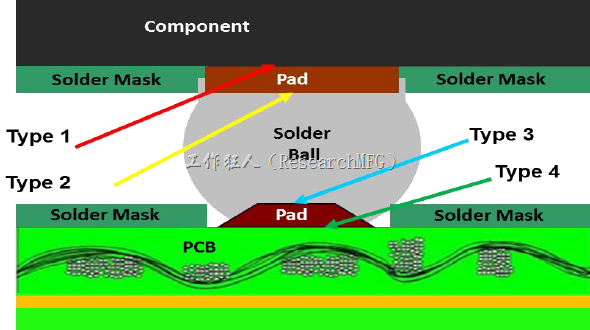
What is the IMC, the Intermetallic Compound? We always heard the manufacturing engineer or some of Mechanical Engineer talking about this keyword when discussing soldering quality or electronic component drop issue. So, what is the role of IMC layer in soldering? Does the IMC layer affect soldering strength and solderability? What is the ideal IMC layer thickness?
The IMC is the abbreviation of Inter-Metallic Compound in the electronic manufacturing industry. The IMC usually grows between the solder alloy and Cu or Ni substrate for the Printed Circuit Board Assembly (PCBA). The IMC is neither a pure metal element nor alloy (Some expert think IMC is a kind of alloy). The IMC is a chemical compound that chemically combined by two or more elements. So, you may see the chemical formula of IMC like Cu6Sn5、Ni3Sn4、AuSn4 ,and so on.
Why Workingbear say the IMC is not an alloy. This is because the behavior is different between IMC and alloy. The alloy is a mixture of two or more metal elements evenly together just like mix the boys and girls in the same classroom. it maybe substitutional or Interstitial alloys. In other words, IMC can be thought of as the child that results from a combination of a boy and a girl, and subsequent chemical reactions.
Since the IMC is a chemical reaction result, so give thermal energy to form the IMC is necessary. Therefore, the solder paste needs to go reflow oven with high temperature to melt the form the IMC with bonding. Only the pure tin (Sn) in the solder paste composition and copper base (for example OSP, I-Ag, I-Sn finished) or nickel base (ENIG finished) in the PCB can cause the diffusion in high temperature and form the firmed interfacial IMC layer.
Where the IMC layer grow?
In the beginning, the interface will grow the good IMC layer of Cu6Sn5. As time and temperature effect that Cu6Sn5 will slowly evolve into poor brittle IMC layer of Cu3Sn. The IMC layer of Ni3Sn4 will grow on the Nickel base PCB. There is no strength degrade risk of IMC layer for the Nickel base PCB except there is black pad quality issue.

The thicker of IMC layer grows the better soldering?
Well, there is a misunderstanding that people think the IMC layer grows the thicker the stronger soldering strength. The IMC layer can be grown and distributed evenly at the interface location will be good enough. Once the IMC layer grows too thick and over 5um then it will become brittle and soldering strength will be reduced.
What is the role of IMC layer in the soldering?
How can we describe the role of the IMC layer in soldering? The growth of the IMC layer serves as an indicator of good soldering. If no IMC layer grows between the solder alloy and the Copper substrate (OSP, HASL) or Nickel substrate (ENIG), then the electronic component and PCB will not be joined. However, it is also the weakest point in the entire soldering strength structure.
Workingbear likens the IMC layer to cement applied between different bricks to construct a wall. The right amount of cement applied evenly can make the bricks join with the best strength, but using too much cement or applying it unevenly will make the wall easily collapse.
Related Article: Why BGA soldering ball always crack(3)? IMC layer growth is a certain result to form the soldering joints
Video to introduce “What is IMC? Part I” – The role of IMC plays in the soldering (revision)
Video to introduce “What is IMC? Part II” – The different between IMC, alloy, eutectic (revision)
Video to introduce “What is IMC? Part III” – Explain Alloy, Eutectic in detail (revision)
Video to introduce “What is IMC? Part IV” – how to judge IMC healthy? (revision)
Related articles:









Hi, I was wondering if you could clarify a question I have.
I measure the IMC in my lab but I measure it in points that I want and after measuring 5 points or 7 points that I want to measure I make an average of the sum of each of the points.
My question is is there a way or a procedure to know how many points I have to measure or what places I have to measure?
For example, should I measure the lowest points and get an average? or should I measure the highest points and get an average? or should I measure 10 points or 15 points and get an average?
Hugo,
You can refer to this paper on the measurement methods of IMC: https://smtnet.com/library/files/upload/IMC-thickness-stats.pdf. However, such measurements are time-consuming. For non-academic research, personally, I suggest measuring the highest, lowest, and visually estimating the “mode thickness” of the slice. Then, provide accompanying illustrations for reference.
Hugo,
Seeking feedback from other friends: Now it’s possible to use image software to capture the IMC area at a fixed magnification. Afterward, dividing it by the length would allow obtaining the average IMC thickness.